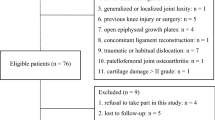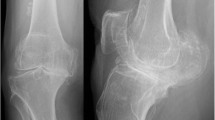Abstract
Purpose
Concomitant unloading procedures, such as high tibial osteotomy (HTO), are increasingly recognized as an important part of cartilage repair. This study presents survival rate, functional outcome, complication rate, and return to work following combined single-stage autologous chondrocyte implantation (ACI) and HTO.
Methods
Forty patients with a mean follow-up of 60 months with isolated full thickness cartilage defects of the medial femoral condyle (MFC) and concomitant varus deformity were included in this retrospective case series. All patients were treated with a single-stage combined ACI and HTO between January 2004 and December 2010. Functional outcome was evaluated prior to surgery and at follow-up using standard scores (Lysholm, VAS, KOOS). Treatment failure was defined as the need for re-operation. Return to work was evaluated using the REFA score.
Results
With all patients (mean age 36.8 SD ± 8.1 years; varus deformity 4.9 ± 1.8 °; mean defect size 4.6 ± 2.1 cm²) a clinical investigation was performed a mean of 60.5 months (SD ± 2.5) postoperatively. Four patients required reintervention (failure rate 10 %). VAS decreased significantly from 6.7 ± 1.9 points preoperatively to 2.2 ± 1.3 points postoperatively. The mean Lysholm score at follow-up was 76.2 ± 19.8 points. The mean KOOS subscales were 81.4 ± 18.0 for pain, 81.3 ± 14.0 for symptoms, 87.6 ± 16.2 for activity in daily living, 66.7 ± 22.8 for function in sport and recreation, and 55.5 ± 22.0 for knee-related quality of living. Mean duration of incapacity from work was 94.5 ± 77 days. Absenteeism from work depended on work load (return to work REFA 0: 68.9 ± 61.4 days vs. REFA 4: 155.0 ± 111.0 days).
Conclusion
Single-stage autologous chondrocyte implantation and concomitant high tibial osteotomy is a reliable and safe treatment with satisfying clinical outcome and improved functional outcome. However, we found a remarkable stay at work rate, which depended on the work load.




Similar content being viewed by others
References
Agneskirchner JD, Freiling D, Hurschler C et al. (2006) Primary stability of four different implants for opening wedge high tibial osteotomy. Knee Surg Sports Traumatol Arthrosc 14(3):291–300
Amendola A (2007) Knee osteotomy and meniscal transplantation: indications, technical considerations, and results. Sports Med Arthrosc 15(1):32–38
Amendola A, Bonasia DE (2010) Results of high tibial osteotomy: review of the literature. Int Orthop 34(2):155–160
Behrens P, Bosch U, Bruns J et al (2004) [Indications and implementation of recommendations of the working group “tissue regeneration and tissue substitutes” for autologous chondrocyte transplantation (ACT)]. Z Orthop Ihre Grenzgeb 142(5):529–539
Bode G, Schmal H, Pestka JM et al (2013) A non-randomized controlled clinical trial on autologous chondrocyte implantation (ACI) in cartilage defects of the medial femoral condyle with or without high tibial osteotomy in patients with varus deformity of less than 5 degrees. Arch Orthop Trauma Surg 133(1):43–49
Bode G, von Heyden J, Pestka J et al (2013) Prospective 5-year survival rate data following open-wedge valgus high tibial osteotomy. Knee Surg Sports Traumatol Arthrosc. doi:10.1007/s00167-013-2762-y
Buckwalter JAMJ, Brown TD (2006) Perspectives on chondrocyte mechanobiology and osteoarthritis. Biorheology 43(3–4):603–609
Cicuttini F, Ding C, Wluka A et al (2005) Association of cartilage defects with loss of knee cartilage in healthy, middle-age adults: a prospective study. Arthritis Rheum 52(7):2033–2039
Cole BJ, Pascual-Garrido C, Grumet RC (2009) Surgical management of articular cartilage defects in the knee. J Bone Joint Surg Am 91(7):1778–1790
Edwards PK, Ackland TR, Ebert JR (2013) Accelerated weightbearing rehabilitation after matrix-induced autologous chondrocyte implantation in the tibiofemoral joint: early clinical and radiological outcomes. Am J Sports Med 41(10):2314–2324
Floerkemeier S, Staubli AE, Schroeter S et al (2012) Outcome after high tibial open-wedge osteotomy: a retrospective evaluation of 533 patients. Knee Surg Sports Traumatol Arthrosc 21(1):170–180
Floerkemeier S, Staubli AE, Schroeter S et al (2013) Outcome after high tibial open-wedge osteotomy: a retrospective evaluation of 533 patients. Knee Surg Sports Traumatol Arthrosc 21(1):170–180
Franceschi F, Longo UG, Ruzzini L et al (2008) Simultaneous arthroscopic implantation of autologous chondrocytes and high tibial osteotomy for tibial chondral defects in the varus knee. Knee 15(4):309–313
Hangody LFP (2003) Autologous osteochondral mosaicplasty for the treatment of full-thickness defects of weight-bearing axis joints: ten year of experimental and clinical experience. Injury 39(Suppl1):32–39
Harris JD, McNeilan R, Siston RA et al (2013) Survival and clinical outcome of isolated high tibial osteotomy and combined biological knee reconstruction. Knee. doi:10.1016/j.knee.2012.12.012
Harris JD, Siston RA, Brophy RH et al (2011) Failures, re-operations, and complications after autologous chondrocyte implantation–a systematic review. Osteoarthr Cartil 19(7):779–791
Heir S, Nerhus TK, Rotterud JH et al (2010) Focal cartilage defects in the knee impair quality of life as much as severe osteoarthritis: a comparison of knee injury and osteoarthritis outcome score in 4 patient categories scheduled for knee surgery. Am J Sports Med 38(2):231–237
Hirschmuller A, Baur H, Braun S et al (2011) Rehabilitation after autologous chondrocyte implantation for isolated cartilage defects of the knee. Am J Sports Med 39(12):2686–2696
Hoell S, Suttmoeller J, Stoll V et al (2005) The high tibial osteotomy, open versus closed wedge, a comparison of methods in 108 patients. Arch Orthop Trauma Surg 125(9):638–643
Lattermann CJR (1996) High tibial osteotomy alone or combined with ligament reconstruction in anterior cruciate ligament-deficient knees. Knee Surg Sports Traumatol Arthrosc 4(1):32–38
Macmull S, Jaiswal PK, Bentley G et al (2012) The role of autologous chondrocyte implantation in the treatment of symptomatic chondromalacia patellae. Int Orthop 36(7):1371–1377
McNamara I, Birmingham TB, Fowler PJ et al (2013) High tibial osteotomy: evolution of research and clinical applications–a Canadian experience. Knee Surg Sports Traumatol Arthrosc 21(1):23–31
Miller BS, Downie B, McDonough EB et al (2009) Complications after medial opening wedge high tibial osteotomy. Arthroscopy 25(6):639–646
Mina C, Garrett WE Jr, Pietrobon R et al (2008) High tibial osteotomy for unloading osteochondral defects in the medial compartment of the knee. Am J Sports Med 36(5):949–955
Minas T, Gomoll AH, Solhpour S et al (2010) Autologous chondrocyte implantation for joint preservation in patients with early osteoarthritis. Clin Orthop Relat Res 468(1):147–157
Muller M, Strecker W (2008) Arthroscopy prior to osteotomy around the knee? Arch Orthop Trauma Surg 128(11):1217–1221
Niemeyer P, Lenz P, Kreuz PC et al (2010) Chondrocyte-seeded type I/III collagen membrane for autologous chondrocyte transplantation: prospective 2-year results in patients with cartilage defects of the knee joint. Arthroscopy 26(8):1074–1082
Niemeyer P, Salzmann G, Feucht M et al (2014) First-generation versus second-generation autologous chondrocyte implantation for treatment of cartilage defects of the knee: a matched-pair analysis on long-term clinical outcome. Int Orthop. doi:10.1007/s00264-014-2368-0
Noyes FR, Barber-Westin SD, Hewett TE (2000) High tibial osteotomy and ligament reconstruction for varus angulated anterior cruciate ligament-deficient knees. Am J Sports Med 28(3):282–296
Pape D, Kohn D, van Giffen N et al (2013) Differences in fixation stability between spacer plate and plate fixator following high tibial osteotomy. Knee Surg Sports Traumatol Arthrosc 21(1):82–89
Rogers BA, David LA, Briggs TW (2010) Sequential outcome following autologous chondrocyte implantation of the knee: a six-year follow-up. Int Orthop 34(7):959–964
Schinhan M, Gruber M, Vavken P et al (2012) Critical-size defect induces unicompartmental osteoarthritis in a stable ovine knee. J Orthop Res 30(2):214–220
Schroter S, Mueller J, van Heerwaarden R et al (2013) Return to work and clinical outcome after open wedge HTO. Knee Surg Sports Traumatol Arthrosc 21(1):213–219
Spahn G, Wittig R (2002) Primary stability of various implants in tibial opening wedge osteotomy: a biomechanical study. J Orthop Sci 7(6):683–687
Sterett WI, Steadman JR, Huang MJ et al (2010) Chondral resurfacing and high tibial osteotomy in the varus knee: survivorship analysis. Am J Sports Med 38(7):1420–1424
Trinh TQ, Harris JD, Siston RA et al (2013) Improved outcomes with combined autologous chondrocyte implantation and patellofemoral osteotomy versus isolated autologous chondrocyte implantation. Arthroscopy 29(3):566–574
Tunggal JA, Higgins GA, Waddell JP Complications of closing wedge high tibial osteotomy. Int Orthop 34(2):255–261
W-Dahl A, Robertsson O, Lidgren L (2010) Surgery for knee osteoarthritis in younger patients. Acta Orthop 81(2):161–164
Willey M, Wolf BR, Kocaglu B et al (2010) Complications associated with realignment osteotomy of the knee performed simultaneously with additional reconstructive procedures. Iowa Orthop J 30:55–60
Wolcott M, Traub S, Efird C (2010) High tibial osteotomies in the young active patient. Int Orthop 34(2):161–166
Author information
Authors and Affiliations
Corresponding author
Rights and permissions
About this article
Cite this article
Bode, G., Ogon, P., Pestka, J. et al. Clinical outcome and return to work following single-stage combined autologous chondrocyte implantation and high tibial osteotomy. International Orthopaedics (SICOT) 39, 689–696 (2015). https://doi.org/10.1007/s00264-014-2547-z
Received:
Accepted:
Published:
Issue Date:
DOI: https://doi.org/10.1007/s00264-014-2547-z




